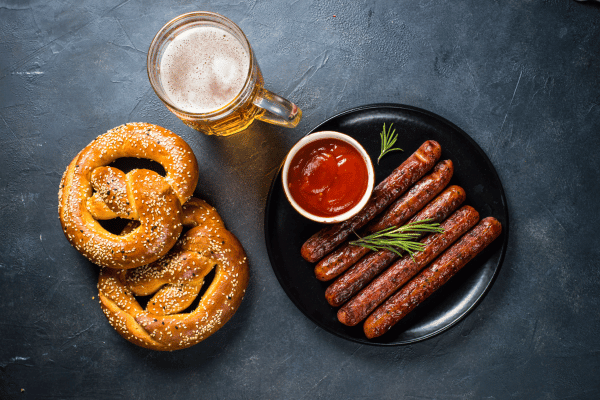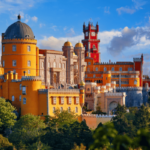
Dive into a world where every region tells a story through its food. Discover German regional cuisine, a tapestry woven with flavors, traditions, and culinary secrets. This journey promises to unveil the rich diversity of Germany’s gastronomic landscape, from hearty Bavarian dishes to the delicate seafood of the North. Prepare to embark on a culinary adventure that will tantalize your taste buds and enrich your travel experiences.
Introduction to German Regional Cuisine
Germany’s culinary map is as diverse as its landscapes, with each region boasting its own unique flavors and traditions. In the South, Bavarian cuisine offers hearty dishes like Knödel and Schweinshaxe, reflecting the region’s love for robust flavors. This introduction serves as a gateway to understanding the depth and breadth of German regional cuisine, inviting food enthusiasts to explore beyond the well-known Schnitzel and Bratwurst.
As we venture further into the heart of Germany, the central regions present a blend of agricultural richness and historical influences in their dishes. Thuringia, for instance, is renowned for its Rostbratwurst, a testament to the area’s sausage-making heritage. This exploration into the central culinary hubs highlights the intricate relationship between regional history and food, showcasing how each dish tells a story of cultural and environmental factors.
Heading North, the cuisine takes a lighter turn, with an emphasis on seafood and fresh produce. The coastal areas, especially, offer an array of dishes that celebrate the bounty of the sea. This transition from the hearty meals of the South to the delicate flavors of the North exemplifies the diversity within German regional cuisine. It’s a journey that promises to surprise and delight, revealing the hidden culinary gems that lie within Germany’s borders.
Bavaria: Land of Beer and Pretzels

Bavaria, Germany’s southern gem, is celebrated for its vibrant beer culture and iconic pretzels. This region, steeped in tradition, hosts the world-renowned Oktoberfest, drawing visitors keen to immerse themselves in the festive spirit. The Bavarian culinary scene is synonymous with conviviality, where beer gardens serve as communal hubs, offering a taste of local hospitality alongside their culinary delights.
Transitioning from the frothy mugs of beer, Bavarian cuisine presents a hearty array of dishes that embody the soul of comfort food. Dishes such as Schweinshaxe (roasted pork knuckle) and Weisswurst (white sausage) are staples, demonstrating the region’s penchant for rich, satisfying flavors. These traditional meals, often accompanied by sauerkraut and sweet mustard, offer a glimpse into Bavaria’s culinary heritage, where every meal is a celebration of local ingredients and time-honored recipes.
Moreover, the humble pretzel, or ‘Brezel’ as it’s locally known, stands as a symbol of Bavarian ingenuity. This twisted bread, with its distinct chewy texture and glossy crust, is more than just a snack; it’s a testament to the region’s baking prowess. Paired with a pint of lager, the pretzel epitomizes Bavarian cuisine’s simple yet profound pleasure, inviting food enthusiasts to discover the rich tapestry of flavors that define this storied land.
The Hearty Flavors of Saxony
Saxony, nestled in the eastern part of Germany, offers a culinary palette that is as rich in history as it is in flavor. The region’s dishes reflect a blend of comfort and sophistication, with a strong emphasis on hearty meats and warming stews. Saxon cuisine, deeply influenced by its past, presents a unique combination of traditional German cooking with subtle Eastern European touches, creating a distinctive gastronomic identity.
One cannot discuss Saxon cuisine without mentioning the celebrated Sauerbraten. This marinated pot roast, often considered the pinnacle of German comfort food, is a testament to the region’s love for slow-cooked, flavorful dishes. Accompanied by red cabbage and Klöße (potato dumplings), Sauerbraten offers a perfect example of how Saxony elevates simple ingredients into a culinary masterpiece, embodying the soulful and rustic essence of the region’s cuisine.
Furthermore, Saxony’s contribution to the world of pastries and sweets is unparalleled. The famous Dresdner Stollen, a fruit bread laden with nuts, spices, and dried fruit, coated in powdered sugar, is especially revered during the Christmas season. This festive specialty, rich in history and taste, encapsulates the warmth and joy of Saxon culinary traditions. It invites food lovers to explore the depth and diversity of German regional cuisine, revealing the layers of culture and history baked into every bite.
Seafood Delights in Northern Germany
Northern Germany, with its vast coastline along the North and Baltic Seas, offers a culinary landscape dominated by seafood. The region’s proximity to the water means that dishes such as fresh herring, mackerel, and flounder feature prominently on menus, showcasing the bounty of the sea. This area’s cuisine is a testament to the German knack for harnessing local resources, turning simple ingredients into delightful meals.
In cities like Hamburg and Lübeck, fish markets are a central part of culinary life, providing locals and visitors alike with access to the freshest catch. Here, traditional recipes like Fischbrötchen, a simple yet delicious fish sandwich, highlight the straightforward yet satisfying approach to seafood that defines the region’s palate. These markets are not just about food; they’re about community and tradition, connecting people to the maritime heritage of Northern Germany.
Moreover, the celebration of seafood in Northern Germany extends beyond the plate to encompass cultural festivals and culinary events focused on maritime delicacies. Events like the Hamburger Fischmarkt offer an immersive experience, allowing one to savor smoked eel, pickled herring, and other regional specialties while soaking in the vibrant atmosphere. These gatherings are a vivid reminder of the central role that the sea plays in shaping the culinary identity of Northern Germany, inviting gastronomes to dive into the rich tapestry of flavors and traditions that make up German regional cuisine.
Rhineland’s Culinary Traditions
The Rhineland, with its rolling hills and verdant vineyards along the Rhine River, boasts a culinary tradition steeped in both history and flavor. This western region of Germany is renowned for its hearty meals, which often feature pork, potatoes, and sauerkraut, creating a comforting and satisfying dining experience. The Rhineland’s culinary offerings reflect the region’s agricultural bounty and historical influences, providing a taste of local life.
One of the standout dishes of this region is Sauerbraten, a marinated beef roast that embodies the Rhineland’s love for rich, deeply flavored meats. Accompanied by potato dumplings and red cabbage, this dish is a celebration of the region’s culinary craftsmanship. The Rhineland’s approach to cooking, which emphasizes slow cooking and robust flavors, showcases the German tradition of creating complex dishes from simple, locally sourced ingredients.
Additionally, the Rhineland is famous for its Riesling wines, which complement the local cuisine beautifully. The region’s vineyards produce some of the world’s finest Rieslings, known for their crisp acidity and subtle sweetness. Pairing these wines with Rhineland dishes enhances the dining experience, allowing the flavors of both the food and wine to shine. This interplay between cuisine and wine is a hallmark of the Rhineland’s gastronomic culture, inviting enthusiasts to explore and savor the rich array of tastes and traditions that define this enchanting region.
Exploring Swabian Comfort Foods
Swabia, a region known for its rolling hills and picturesque landscapes in southwestern Germany, offers a unique culinary tradition that revolves around comfort and simplicity. The Swabian kitchen is famous for its down-to-earth dishes that warm the heart and soul, such as Spätzle, a type of soft egg noodle that is a staple in Swabian households. This dish, often served with cheese or as a side to meaty stews, exemplifies the region’s approach to hearty, home-cooked meals.
Another iconic Swabian dish is Maultaschen, a type of dumpling filled with spinach, meat, and onions, encased in a thin pasta dough. This dish, often described as the German answer to ravioli, is steeped in tradition and local lore. Swabians pride themselves on the craft of making Maultaschen, which is a testament to the region’s culinary ingenuity and the importance of food in bringing people together.
Moreover, Swabian cuisine is not just about the food; it’s about the experience of gathering around the table, sharing stories, and enjoying the simple pleasures of life. The region’s culinary offerings invite you to slow down and savor each bite, whether it’s a warm slice of Apfelkuchen (apple cake) or a hearty bowl of Linsen mit Spätzle (lentils with noodles). It’s this emphasis on community and comfort that defines Swabian cuisine, making it a vital part of the mosaic that is German regional cuisine.
Berlin’s Diverse Food Scene

Berlin, the pulsating heart of Germany, is a melting pot of cultures and cuisines, making it a vibrant center for food enthusiasts. The city’s diverse food scene is a reflection of its multicultural population, offering everything from traditional German dishes to international delicacies. This culinary diversity not only enriches Berlin’s gastronomic landscape but also provides a unique way to experience the world through food, right in the capital.
In the bustling streets of Berlin, one can find an array of food markets and street food stalls that serve up a variety of flavors. From the classic Currywurst to Turkish Döner Kebabs and Vietnamese Pho, the options are endless. This accessibility to a wide range of cuisines speaks to Berlin’s open, inclusive nature, where every palate is catered to and every cuisine celebrated. It’s this spirit of culinary exploration that defines Berlin’s food scene.
Moreover, Berlin’s commitment to sustainability and organic produce is evident in its numerous farm-to-table restaurants and weekend farmers’ markets. The city’s food scene is not just about the diversity of flavors but also about mindful eating and the promotion of local, seasonal ingredients. This approach adds another layer to the gastronomic experience in Berlin, inviting visitors and locals alike to discover and appreciate the rich tapestry of tastes, traditions, and innovations that make up the city’s dynamic food landscape.
German Food Festivals: A Culinary Celebration
Germany’s food festivals are a vibrant testament to the country’s rich culinary heritage, offering a lively platform for both locals and visitors to indulge in the nation’s diverse gastronomic delights. These festivals go beyond mere eating; they are celebrations of culture, tradition, and the communal joy of sharing good food. From the bustling Christmas markets with their array of seasonal treats to the lively beer festivals, each event is a unique culinary adventure.
One of the most iconic food festivals is the Oktoberfest in Munich, renowned globally for its lively atmosphere and abundance of traditional Bavarian food and beer. However, beyond the beer steins and lederhosen, there’s a wide variety of German regional cuisine on offer, showcasing the country’s culinary diversity. These festivals provide an immersive experience, allowing attendees to savor local specialties and discover new flavors in a festive setting.
Moreover, regional food festivals throughout Germany offer a more intimate glimpse into the local culinary scene. Events like the Berlinale Culinary Cinema combine film and food, while the Hamburger Fischmarkt celebrates the best of Northern Germany’s seafood. These festivals are not just about tasting food but about experiencing the stories and traditions behind the dishes. They invite everyone to partake in the communal spirit of German gastronomy, making food festivals an essential part of exploring German regional cuisine.
Tips for a German Culinary Tour
Embarking on a culinary tour across Germany offers an enriching way to experience the country’s diverse food culture. To make the most of this journey, it’s crucial to venture beyond the popular tourist spots and explore where locals dine. Discovering hidden gems, from quaint bakeries in cobblestone alleys to cozy taverns in small towns, can lead to authentic culinary experiences that capture the essence of German regional cuisine.
Incorporating visits to local markets into your itinerary is another valuable tip. These markets often feature the freshest produce, artisanal cheeses, meats, and other regional specialties. Engaging with local vendors not only supports the community but also provides insights into the culinary traditions and ingredients that define the area’s cuisine. This hands-on approach allows for a deeper understanding and appreciation of the regional dishes and flavors you’ll encounter.
Lastly, timing your visit to coincide with regional food festivals can greatly enhance your culinary tour. These events offer a festive and comprehensive sampling of local cuisines, often with the added bonus of traditional music and entertainment. Whether it’s sampling the finest Bavarian beers at Oktoberfest or savoring freshly caught fish at a coastal festival, aligning your travel with these celebrations can provide a memorable and immersive gastronomic experience, truly bringing to life the rich tapestry of German regional cuisine.
Conclusion: Embracing German Gastronomy
As our gastronomic journey through Germany comes to a close, it’s clear that the country’s culinary landscape is as diverse and rich as its history and culture. From the hearty, comforting dishes of Bavaria to the delicate seafood offerings of the North, each region contributes its own unique flavors and traditions to the tapestry of German cuisine. This exploration has not only been a feast for the taste buds but also a deep dive into the heart of German culture.
The journey through Germany’s culinary regions teaches us that food is more than sustenance; it’s a narrative of the people, their land, and their history. Each dish, from the simplest bread to the most elaborate feast, tells a story of centuries-old traditions, seasonal rhythms, and local pride. As travelers and food lovers, we’re invited to partake in these stories, to savor and appreciate the rich diversity that defines German regional cuisine.
In conclusion, discovering German regional cuisine is an adventure that extends beyond the plate. It’s an invitation to immerse oneself in the country’s cultural heritage, to connect with locals over shared meals, and to celebrate the universal language of good food. As we reflect on this journey, we’re reminded of the power of cuisine to unite and inspire, encouraging us to continue exploring the vast and varied world of flavors that Germany, and indeed the world, has to offer.
in summary
Embarking on a journey through Germany’s culinary landscape reveals a mosaic of flavors, each region presenting its own unique culinary identity. From the hearty meat dishes of Bavaria to the fresh seafood of the northern coasts, the variety is astounding. This exploration into German regional cuisine not only satisfies the palate but also weaves a rich narrative of Germany’s cultural and historical tapestry, making each meal a discovery of tradition and innovation.
Moreover, the adventure through Germany’s gastronomic offerings highlights the importance of locality and seasonality in German cooking. The commitment to using fresh, local ingredients not only enhances the flavors but also supports local economies and sustainable practices. This journey encourages a deeper appreciation for the craftsmanship involved in traditional German cooking, from the brewing of beer to the baking of bread, each process steeped in centuries-old traditions.
In conclusion, to discover German regional cuisine is to embark on a culinary adventure that offers more than just delicious food; it offers a deeper understanding and appreciation of Germany’s diverse cultural heritage. As we reflect on this flavorful journey, we’re reminded of the power of food to bring people together, to tell stories, and to celebrate the richness of regional diversity.
III. Frenquently Asked Questions About Germany
- How is the German economy structured?Germany has a social market economy, being the largest in Europe and known for its engineering, manufacturing, and exporting prowess, particularly in the automotive, machinery, and chemical sectors.
- What are some environmental initiatives in Germany?Germany is a leader in environmental sustainability, with initiatives focusing on renewable energy, waste reduction, and conservation efforts, aiming to become carbon neutral by 2050.
- What should I know about German beer culture?German beer culture is integral to its social fabric, with over 1,300 breweries producing thousands of beer varieties. Reinheitsgebot, or the Beer Purity Law, ensures the quality of German beer by limiting ingredients.
- Can you explain the significance of German castles?German castles, such as Neuschwanstein and Heidelberg Castle, are steeped in history, offering insights into the country's medieval past, fairy-tale landscapes, and architectural marvels.
- How does the German political system work?Germany is a federal parliamentary republic, with the Chancellor as the head of government. It has a two-chamber parliament: the Bundestag (Federal Diet) and the Bundesrat (Federal Council), representing the 16 federal states.
- What are some traditional German crafts and industries?Traditional German crafts include cuckoo clocks from the Black Forest, porcelain from Meissen, and beer steins. These industries reflect Germany's rich cultural heritage and craftsmanship.
- What are the visa requirements for visiting Germany?Visitors from many countries can enter Germany without a visa for stays of up to 90 days for tourism or business purposes. However, it's essential to check the latest visa requirements based on your nationality.
- What is the German approach to work-life balance?Germans highly value work-life balance, with laws regulating working hours and vacation entitlements. Many businesses close early on Saturdays and remain closed on Sundays, emphasizing the importance of leisure and family time.
- How is soccer integrated into German culture?Soccer (football) is deeply ingrained in German culture, with passionate support for local and national teams. The Bundesliga is one of Europe's top soccer leagues, and Germany has won the FIFA World Cup four times.
- What are some tips for shopping in Germany?When shopping in Germany, look out for local specialties and crafts, such as Bavarian lederhosen, Berlin's avant-garde fashion, and traditional Christmas ornaments. Most shops are closed on Sundays, except for some bakeries and convenience stores.

Ryan Taylor, a seasoned traveler with over a decade of experience exploring Europe’s nooks and crannies, offers a wealth of knowledge and unique insights into the continent’s diverse cultures and landscapes. His passion for travel began in his early twenties, and since then, Ryan has journeyed through numerous European countries, collecting stories, tips, and a deep understanding of each destination’s unique charm. His blog entries are not just guides but narratives enriched with personal experiences, making every recommendation and piece of advice relatable and practical for fellow travel enthusiasts. With a keen eye for hidden gems and a love for sharing his adventures, Ryan’s writings are a treasure trove for anyone seeking to discover the beauty and richness of Europe.






